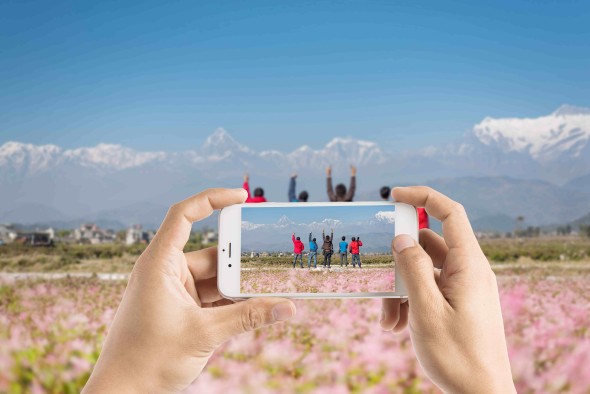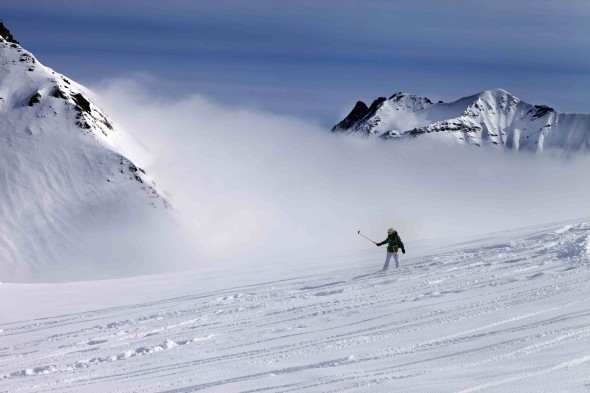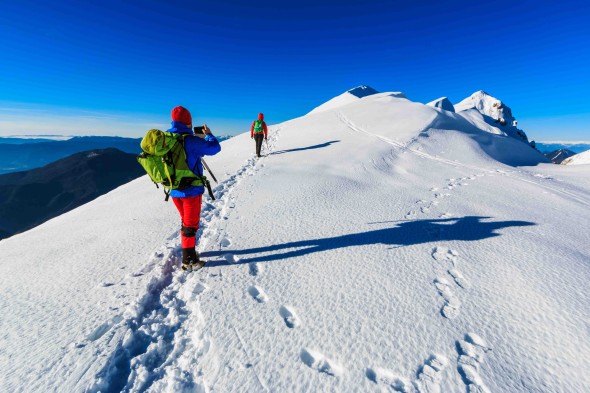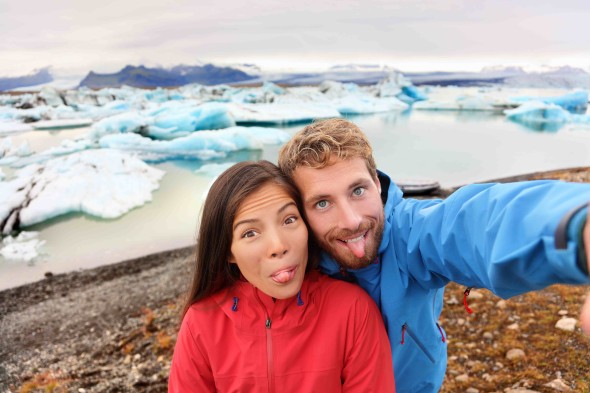Is the popularity of Facebook, Twitter et al a good or bad thing for the outdoors? Sophie Nicholson investigates…

If it’s not on social media it didn’t happen, right?
When Tommy Caldwell and Kevin Jorgesen made the first free ascent of the Dawn Wall in Yosemite in January this year, they succeeded in making more than just climbing history. Over the course of 19 days spent on the wall, the pair climbed 32 pitches, sanded and super glued their fingers, and dragged themselves 2,500ft upwards in the direction of a long-held dream through a combination of sheer will and extraordinary skill. What they achieved in climbing terms was extraordinary, but the way in which their adventure was documented was arguably even more groundbreaking.
When the pair left the ground just after Christmas, only the core climbing audience was watching, yet when they arrived on the summit of El Capitan a mere two and half weeks later the eyes of the whole world were firmly fixed upon them. The duo’s quest captured the imagination of a global mainstream audience who followed their journey minute-by-minute, hour-by-hour online via social media and live video updates. Tommy and Kevin may have left the ground as high-profile climbers but when they topped out they had been transformed into household names and internationally-known sport superstars. The media frenzy surrounding their achievement was unprecedented and far-reaching with even Barack Obama himself sending his congratulations from the White House. The Dawn Wall had been climbed for the first time, but more significantly, Tommy, Kevin and rock climbing itself had gone viral on a level not seen in mountain sports before.
Without wanting to detract from the pair’s achievement in climbing terms, the primary reason for this global acclaim can be attributed to one very powerful medium – social media. Throughout the climb, both Tommy and Kevin were fully connected and pushing out media updates to an increasingly hungry online audience. A combination of tweets, Facebook status updates, photos and live video updates brought their adventure direct from the portaledge and onto the screens of millions of smartphones across the world. Such was the extent of the online connection between the climbers and their transfixed followers that Tommy and Kevin even hosted a Q&A session using the hashtag #AskDawnWall, enabling fans to become even more involved with the project. The fascination and momentum grew to such an extent that a live stream was established on the 14th January to enable the whole world to watch as Tommy and Kevin finally reached the top of the route.

Are head-mounted cameras and selfie sticks a hazard in the mountains?
The aftermath of this media hype understandably raised numerous questions surrounding the role that connectivity has to play in adventure in general. Whilst the power of social media has become abundantly evident in all of our lives, what happened in Yosemite in January this year kickstarted a wider debate between climbers and non-climbers alike as to whether the likes of Twitter, Facebook, Instagram and YouTube are having a positive or negative affect on all of our mountain experiences. Whilst one cannot argue that the Dawn Wall social media campaign increased the exposure of climbing worldwide and therefore more than likely inspired many thousands to take up the sport, it also highlighted a more general and slightly depressing trend – that the apparent need to constantly be documenting our outdoor exploits online has become so prevalent that some believe it is in danger of threatening the very essence and soul of what mountain adventures are all about.
CHANGING TIMES
To understand the validity of social media in modern day adventuring, we need to first try to put it in context. It is, for example, worth reminding ourselves that the vast majority of human-powered adventures throughout history have always been recorded in some manner and, more often than not, these accounts have been shared. From carved etchings in caves to handwritten expedition journals, intricate sketches and inspirational photographic images, mankind has long since had a habit of leaving records of his exploits. Whilst a ‘selfie’ is not exactly a work of art, it could be argued that posting such updates on social media is nothing more than a basic modern day extension of what we have been doing for centuries – sharing our stories and creating conversation.
If social media can be viewed as a natural progression in human-created storytelling then it automatically becomes less of a threat and hence is easier to accept as having some kind of role to play in our mountain adventures. Moreover, when used ‘correctly’ social media has the potential to be a very valuable tool indeed and as a result could be perceived as a positive contributor to, rather than a detractor from, the overall outdoor experience. For example, one of the key skills a mountaineer must possess is the ability to make good decisions, and in order to do this effectively we need to acquire information – there is a reason why Francis Bacon claimed that ‘knowledge is power’. If social media helps influence this process by making more real-time information available, this has to be a good thing. Nowadays we can gather key information about conditions ahead of time, collect data to facilitate safe and appropriate route choices and collaborate with our peers, all from the palm of our hands. The flip side, of course, is when this information is processed and applied inappropriately, and this is one of the main reasons that social media has so many enemies in the outdoor and mountaineering worlds.
Deciding to climb or ski a line purely because you’ve seen it done on Instagram is irresponsible at best, suicidal at worst. Choosing which route to take in the mountains depends not just on a number of individual factors but on many key combinations of these factors. For example, the weather forecast might look good but is the snowpack stable? The snowpack might be stable on a 25 degree, south-facing slope but how are things looking on a steeper, north-facing slope? The long-awaited 40 degree line on the north-facing slope might have just come into condition, but are you in the appropriate physical shape to take it on in the short window of safety before the temperatures warm up? If the temperatures warm up, have you got a back-up plan? The questions may be endless but constant inquiry is imperative to facilitate safe passage in the mountains. Conditions can, and do, change by the minute so using someone else’s head cam, say, as the sole reference point for your decisions is quite clearly wildly inappropriate.
The majority of us are sensible enough not to actually use a photo posted on Facebook as the only factor in our decision-making process, yet many experienced mountain-goers are extremely wary of social media. The main conflict surrounding its effect on our outdoor life seems to be related to ‘how it makes us feel’. Logging onto our social media accounts and constantly being exposed to other people’s achievements and adventures seems to affect people in different ways. While some people find it inspirational, a vast majority claim that being exposed to others’ adventures on social media makes them feel under pressure, distracted and unsatisfied.

I wonder how many Instagram ‘likes’ I’ll get with this pic?
Such is the extent of this ‘disease’ that it has been given an official name – ‘FOMO’, or Fear of Missing Out. FOMO is defined in the Oxford Dictionary as an ‘anxiety that an exciting or interesting event may be happening elsewhere, often aroused by posts seen on a social media website’. At first glance FOMO sounds terrifying but, on reflection, it is nothing new. While most people do not admit to feelings of jealousy, it is widely agreed that envy is deeply ingrained in human nature. As Michael Dirda wrote in his 2013 article in The Washington Post, “like most people, I know that the real party will always be happening in the next room.” Whilst the best antidote for FOMO or any other similar disease is surely to apply ‘the grass is always greener’ mentality (or to simply get off your computer, go outside and do something life-affirming), the fact that both FOMO and ‘selfie’ were given official entry into the Oxford Dictionary in 2013 only goes to reinforce the ever-increasing reach of the potent tentacles of the social media monster.
COMMERCIAL PRESSUES
If so many regular outdoor enthusiasts’ emotional and mental well-being can be threatened to such an extent that new phrases and terminology have been created to legitimise this ‘condition’, how must it be for the professional mountain athlete? Pretty tricky by all accounts. As ultra-runner Mike Wolfe explains, “Most major sponsors do analytic tracking of athletes’ social media presence as a way to determine our value, relevancy in our sport, influence, and brand presence, above and beyond mere results in competition… to some extent, this is a job requirement.” If you want to make a living as a professional outdoor athlete these days, then, it would appear you need to spend as much time building your online profile as you do out in the hills and down the gym.
In Rachel Savage’s ‘Peak Profits’ article for Management Today, professional climber Hazel Findlay reveals, “One reason the best climbers can’t make money out of climbing is that brands want more than an athlete who can climb hard. They want people who can promote themselves and the brand.” While Findlay herself is doing pretty well both on the rock as a pro climber with sponsors such as The North Face and Black Diamond and on social media with 21,000 Instagram followers and 15,000 Facebook likes, for millions of other athletes who do not understand the rules, it’s a complex game to play. Global Marketing Director for Adidas’s outdoor division Axel Burkhardt is brutally honest about the situation, revealing that Adidas won’t even consider sponsoring athletes who do not have a sufficient online presence. Unless of course they are particularly young and talented, “then you can build him up and he belongs to us.”
Whilst this modern-day, cut-throat attitude doesn’t exactly sound like the dirtbag dream so many of us with a tendency towards nostalgia dream about, it is important to be realistic. Professional sport is a business just like any other and whether you are a glitzy, bejewelled footballer or hairy chalk-covered climber, if someone is paying you to ‘play’, then they will want a return on their investment. It may be a game, but when there’s money involved it’s a serious one, and in order to compete you have to accept the rules. After all, we can only find out about new ventures and new horizons if they are recorded, so it’s important that those who are doing the exploring and pushing towards new limits document their particular journey. This used to be done by writing books and doing lecture tours, but in the digital age professional athletes need to both inspire through a combination of performance and influence via social media. It may be a lot of work but it kind of comes with the territory, and if done professionally it can have an extremely impressive effect. Through clever use of social and other media the likes of the Dawn Wall duo, Danny MacAskill and Kilian Jornet have inspired many millions around the world to get outdoors and commit to their passions, and in an increasingly sedentary world that can only be a very good thing.
A TWEET TOO FAR?
Social media may be pervasive but it seems that the majority of problems arise when it crosses a line and becomes invasive. A lot of what makes mountain adventures so valuable is that they offer a rare opportunity to switch off from the hectic demands of day-to-day life, stop the constant flow of information flooding our screens and minds and fill ourselves up with a simpler, natural and pure experience. Days in the hills are precious and the last thing you want is to be constantly having an iPhone or GoPro shoved in your face. Taking pictures so that you have lasting memories of an experience is one thing, but when it becomes about a need to make a record of the day rather than simply enjoying the experience itself, then priorities have become more than a bit skewed. At this point you are moving into a dangerously narcissistic area, one where advertising your experiences on your social media feed has become more important than the very act of just being there and enjoying them.
“Everybody now seems to be preoccupied with their phone and Facebook” uber mountain athlete Ueli Steck observed in a recent interview with Trek & Mountain, “it seems that the most important part is that as soon as they get back they have to post where they were, what they did and they just miss the moment. I don’t bring a phone to go for a run; it’s like, no. I just go for a run and just enjoy it.” Last Frontier Heliskiing’s D’Arcy McLeish went even further in a recent blog post, stressing the need to “cherish the endeavour itself more than making a record of that endeavour happening” – wise words indeed.
Whether it is used as a point of reference, a boasting platform or a source of inspiration, social media is a tool for communication that can be viewed and applied in many different ways. It is without a doubt a medium that connects us on a variety of levels, and more than anything else it is this ability to bring us together that makes it such a powerful application. During the recent devastating earthquakes in Nepal we witnessed social media being used in the most convincing of manners. This was arguably the moment when its full potential was revealed and we saw social media functioning as a mature and utterly compelling communications medium. In the immediate confusion and aftermath of the earthquakes, many social media networks initiated safety features that enabled people to locate missing friends and family. Facebook for example, activated their ‘Safety Checker’ within hours of the incident. “When disasters happen, people need to know their loved ones are safe. It’s moments like this that being able to connect really matters” said founder Mark Zuckerberg.
Expedition organiser and leader Dan Mazur of Summit Climb was at Camp 1 on Everest when the avalanche struck and was using his satellite phone to Tweet news and updates direct from the mountain. In the confusion and immediate aftermath of the tragedy, Dan’s social media feed swiftly became one of the key sources of information for concerned family members, journalists and the many millions of regular people watching as events unfolded on the world’s highest mountain. Reporters were knocking on the doors at the Summit Climb Bristol office, desperate to connect to Dan and the rest of his team on Everest. Whilst a climber at core who enjoys the solitude that comes from being in the mountains, he understands the invaluable role that social media has to play in creating a flow of communication in modern mountaineering: “When we’re in the Himalayas, we’re often in valleys where there’s no mobile reception so we have to use other resources. When a friend from Finland told me that you could tweet from your satphone, it was a game-changer. Personally I never use social media when I’m not in the field, but when I am on a trip I use it every day. It’s really useful for keeping people at home informed, whether they want to stay in touch with loved ones or just find out what’s going on during a climb. I’m always looking for ways to communicate with people back at home and the immediacy of social media is amazing. It encourages people to participate.”

What better way to celebrate being in an amazing place by sticking tongues out and taking a selfie?
MATTER OF CHOICE
To put social media in a box that defines it as either ‘positive’ or ‘negative’ would seem to be both over-simplistic and inherently unhelpful. It is undoubtedly an enormously powerful communications tool that can be used for many different purposes, and as such has the potential to influence our outdoor experiences in a variety of ways. The key to all of this is how the tool is applied; we are entirely in control of how we use and react to social media, so if other people’s social media feeds make us feel unsatisfied with life or under pressure in some way then we have two choices: get outdoors ourselves or don’t log onto social media. If we hate having iPhones continually shoved in our faces in the hills, then quite simply we need to go out with different partners.
As long as our eyes are open and when it really matters, we put down our various devices and are able to be ‘in the moment’, then social media cannot be viewed as a threat to the spirit of adventure. As Duane Raleigh pointed out in a recent piece on Rock & Ice online, “Adventure, arguably, is the mental and physical challenge, while exploration is the journey into the unknown… we watched Neil Armstrong step on the moon via a live television feed, and I don’t recall anyone saying, ‘well, there goes adventure!’”
Social media may be pervasive and powerful but it has no control over any of our adventures unless we feed it. The buck 100% stops with us. Now close the computer, go outside, leave your iPhone in your pocket and BREATHE!

